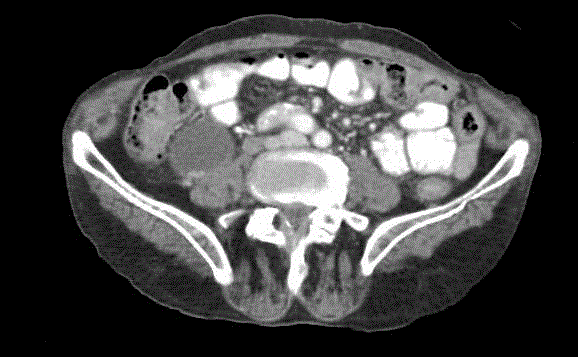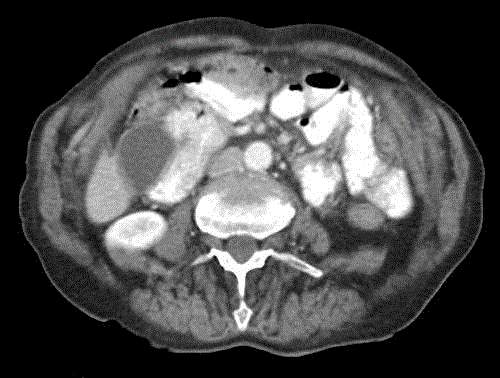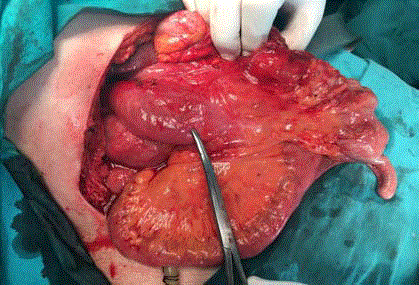Case Report
Ectopic Localization of the Gallblader at Posterior Caecum and Ascending Colon
Mesut Tez* and Sadettin E
Department of General Surgery, Ankara Numune Hospital, Ankara, Turkey
*Corresponding author: Mesut Tez, Department of General Surgery, Ankara Numune Hospital, Ankara, Turkey
Published: 22 Nov 2017
Cite this article as: Tez M, Sadettin E. Ectopic Localization
of the Gallblader at Posterior Caecum
and Ascending Colon. Clin Surg. 2017;
2: 1749.
Abstract
Ectopic localization of the gallbladder is a rare condition with an incidence of 0.1% to 0.7%. A
71-year-old male patient is admitted to the emergency room with abdominal pain. Patient with high
bilirubin and cholestasis enzymes biochemical parameters were performed abdominal USG and CT.
In preoperative abdominal CT, gallbladder was found ectopically located posteriorly of the right
colon. ERCP was performed because of persistence of bilirubin levels, extrahepatic and hilus level
intrahepatic bile duct dilation. Patient underwent open cholecystectomy with normal cholestasis
enzymes and bilirubin levels.
Keywords: Right colon posteriorly located gallbladder; A new localization; Caecum
Introduction
Ectopic localization of the gallbladder is a rare condition with an incidence of 0.1% to 0.7% [1]. The aim of this study was highlighting the gallbladder which has same clinical findings as normal gallbladder stone, but has anatomical and embryological based anomaly and ectopic localization.
Case Presentation
A 71-year-old male patient is admitted to the emergency room with abdominal pain which
was started one day before. The patient have not had any additional clinical symptom or additional
disease and history of abdominal operation. There were minmally epigastric and right subcostal
tenderness at physical examination. The laboratory findings was; White Blood Cell count (WBC);
9800, Total bilirubin; 2.3 mg/dl, Direct bilirubin; 1.9 mg/dl, liver function tests; AST; 512 IU/L,
GGT; 246 IU/L, and ALP; 486 IU/L. At biliary Ultra Sound (US), there were gallbladder hydrops,
minimal increase in thickness of the gallbladder wall, and multiple millimetric stones at gallbladder
lumen. Additionally, there were dilatation at intrahepatic biliary ducts but common hepatic duct
couldn’t be assessed. Abdominal Computer Tomography (CT) had been performed to the patient
with these findings. At abdominal CT, gallbladder localized at posterior of the ascending colon and
caecum, there were stones at gallbladder lumen, and dilatation at intrahepatic biliary ducts (Figure
1 and 2) During follow up Endoscopic Retrograde Cholangio Pancreatography(ERCP) has been
performed because of the persistence at increased bilirubin levels. The sphincterotomy for oddi
sphincter have been performed and stones at intrahepatic ducts have been extracted with ERCP.
After bilirubin levels decreased to normal levels, open cholecystectomy have been performed
to the patient. In the operation; fundus of the gallbladder have been mobilized from posterior
ascending colon, and then cholecystectomy have been performed (Figure 3). After 3 days from operation patient has been discharged without any complication.
Final pathology have been reported as chronic cholecystitis.
Figure 1
Figure 2
Figure 3
Discussion
Ectopic localization of the gallbladder is a rare condition with
an incidence of 0.1% to 0.7% [1]. Gallbladder anomalies can be
classified as count (agenesia, bilobular gallbladder, multiseptate
gallbladder), shape (phrygian cap gallbladder, diverticulum of
gallbladder, hypoplasia or rudimentary gallbladder), and position
(left side localised, transverse position, suprahepatic or intrahepatic
gallbladder). Agenesia is the most common anomalie of the
gallbladder [2]. Additionally, in the literature, there were studies that
reported the gallbladder could be find at different localisations like
retroperitoneal, lesser sac, retroduodenal, falciform ligament, inside
the abdominal muscles and inside the thorax [1,3,4] Ehman et al.
[5] reported a case that gallbladder localized at retrorenal area. Our
case is the first case of the literature that describes the gallbladder at
posterior of the ascending colon.
Abnormal position of gallbladder can cause diagnosis problems
at US. In such cases, different localizations should be considered in
the presence of long cystic duct, biliary absent in the normal liver
bed, and presence of suspicious cystic duct [6]. Abnormal localised
gallbladder must be removed even the patient was asymptomatic
[7]. Description of the gallbladder’s localization accurately, is an
important point for the right choice of surgery type [8]. US, CT, and
cholescintigraphy are the most common modalities for description
of the localization of the ectopic gallbladder [9]. CT can determine
all ectopic gallbladders localizations accurately, and Magnetic
Resonance Cholangio Pancreatography(MRCP) additionally can
identify biliary duct abnormalities [10,11]. Also in our case, CT was
the most important imaging modality for description of gallbladder
localization and making a decision on the choice of surgery type too.
Conclusion
Our case is the first case of the literature that describes the gallbladder at posterior of the ascending colon. We use CT for diagnosis of ectopic gallbladder and choose open cholecystectomy procedure for treatment of the patient.
References
- Haaga J, Herbener T. The gallbladder and biliary tract. CT and MR imaging of the whole body, 4th ed. St Louis, MO: Mosby. 2003:1341-94.
- Stolkind E. Congenital Abnormality in the Shape of the Gall-bladder and Extra-hepatic Ducts. Adlard and son. 1939.
- Chowbey PK, Wadhwa A, Sharma A, Khullar R, Soni V, Baijal M. Ectopic gallbladder: laparoscopic cholecystectomy. Surg Laparosc Endosc Percutan Tech. 2004;14(1):26-8.
- Gross RE. Congenital anomalies of the gallbladder: a review of one. Hundred and forty-eight cases, with report of a double gallbladder. Archives of Surgery. 1936;32(1):131-62.
- Ehman RL, Morrish HF. Retrorenal gallbladder. A case report. J Can Assoc Radiol. 1983;34(4):321-2.
- Pradeep VM, Ramachandran K, Sasidharan K. Anomalous position of the gallbladder: ultrasonographic and scintigraphic demonstration in four cases. J Clin Ultrasound. 1992;20(9):593-7.
- Alkatout I, Henopp T, Moritz JD, Nikischin W, Klöppel G, Engler S. Extra abdominal mal position of the gallbladder. J Pediatr Surg. 2008;43(11):e41-4.
- Popli MB, Popli V, Solanki Y. Ectopic gall bladder: A rare case. Saudi J Gastroenterol. 2010;16(1):50.
- Rather TA, Khan SH, Singh M, Choh NA. A rare case of suprahepatic gall bladder with phocomelia and pancytopenia: detected by tc-99m mebrofenin scintigraphy. World J Nucl Med. 2013;12(1):41-4.
- Hibbs H, Ahmad U. Inverted liver with suprahepatic, anteriorly displaced gallbladder. J La State Med Soc. 2010;162(3):150-2.
- Singh A, Holmes RA, Witten DM. Scintigraphic demonstration of a gallbladder anomaly. AJR Am J Roentgenol. 1985;144(1):77-8.



